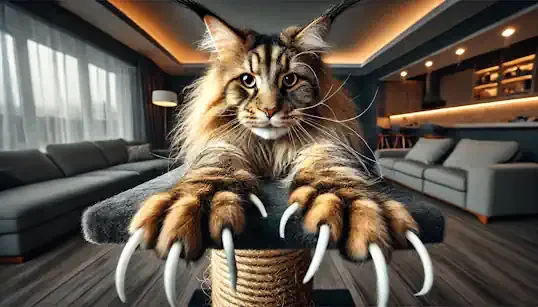Scratching furniture. It’s a common feline behavior that can frustrate even the most dedicated cat lovers. We understand the exasperation of finding your prized sofa slowly being transformed into a shredded mess. The knee-jerk reaction might be to consider a quick fix, a seemingly simple solution to protect your home décor: declawing. But before you even entertain the thought of declawing for your cat’s “destructive” scratching, we urge you to pause, to truly consider what this procedure entails, and to ask yourself this crucial question: are you willing to remove your cat’s very ability to defend themselves, just to save your furniture?
Imagine for a moment having your own fingers amputated at the first knuckle. Imagine living with that permanent loss, the altered sensation, the phantom pains that might linger, all because your hands occasionally touched things that someone else deemed undesirable. That, in essence, is what declawing is for your cat. It’s not a mere nail trim, not a simple cosmetic procedure. It is a serious surgical intervention, a drastic measure with profound and lasting consequences for your cat’s physical and emotional well-being, impacting their very ability to feel safe and secure in their world, to fulfill their most basic instinct to defend themselves if necessary.
Let’s be unequivocally clear from the outset: this article takes a firm stance against declawing. We believe it is a harmful and unnecessary procedure, a practice rooted in misunderstanding and human convenience that prioritizes furniture preservation over the fundamental welfare of our feline companions. We will argue, unequivocally, that your cat needs to be able to defend themselves, and declawing irrevocably robs them of this vital capability. We will delve into the stark reality of what declawing truly is, expose the devastating physical and behavioral consequences it inflicts, and explain why even indoor cats retain this essential need for self-preservation. Most importantly, we will showcase the humane and effective alternatives available – real solutions that allow you to protect your furniture and protect your cat's well-being, ensuring they remain happy, healthy, and crucially, able to feel secure in their world.
The term "declawing" itself is deceptively gentle, almost euphemistic. It conjures an image of simply trimming or removing the claws, like a routine manicure. This is a dangerous and deeply misleading misconception that needs to be shattered. Declawing is not nail removal. It is, in fact, a series of amputations. To understand the true nature of declawing, you must understand feline anatomy. A cat’s claw is not simply attached to the toe; it grows directly from the last bone of the toe, known as the distal phalanx, or the third phalanx. Declawing, surgically speaking, is the amputation of this distal phalanx – the very last bone on each of a cat's toes. Imagine having the tip of each of your fingers surgically removed at the first knuckle. That's the anatomical equivalent of what your cat endures with declawing.
This is not merely nail removal; it is bone amputation. The procedure involves surgically severing not only bone but also tendons, nerves, and blood vessels in each toe. It is a significant surgical trauma, a deeply invasive and painful process. There are different surgical techniques employed for declawing, including the guillotine clipper method, laser declawing, and the traditional scalpel method. The guillotine clipper method utilizes a sharp clipper to sever the bone and joint. Laser declawing uses a laser to cut through the tissue and bone, cauterizing blood vessels as it cuts, sometimes marketed as “less painful,” but still fundamentally involves amputation and nerve damage. The scalpel method, arguably the most traditional, involves using a scalpel blade to surgically dissect and remove the distal phalanx. Regardless of the technique used, the fundamental outcome is the same: the amputation of the bone from which the claw grows.
The consequences of this amputation are both immediate and long-lasting, profoundly impacting the cat's life. In the immediate aftermath of surgery, cats experience significant pain. Pain management is crucial post-operatively, but even the most effective pain relief cannot completely eliminate the discomfort and trauma of having ten bones amputated. Beyond immediate pain, there is a significant risk of infection at the surgical sites. These open wounds, located on the paws that cats use to walk in their litter boxes, are inherently vulnerable to bacterial contamination and infection. Limping and lameness are common short-term consequences, but for some cats, altered paw structure and persistent pain can lead to chronic limping and lameness that can last for months, years, or even a lifetime. Severing nerves during amputation can lead to permanent nerve damage and the development of chronic pain syndromes. Phantom pain, similar to that experienced by human amputees, is a real possibility for declawed cats, where they experience pain sensations in the missing toes. Incomplete removal of the bone during declawing can lead to the formation of painful bone spurs or the retention of bone fragments, both of which can necessitate further surgery to correct. Over time, the altered gait and weight distribution caused by declawing can place increased stress on the cat's joints. This can significantly increase the risk of developing arthritis and joint problems later in life, particularly affecting the shoulders, elbows, and paws. Finally, the very shape of the paw itself changes after declawing. The natural mechanics of walking and running are altered, contributing to the altered gait and potential for long-term joint problems. Declawing is not a simple fix; it is a cascade of physical trauma and potential long-term health issues inflicted upon your cat.
Beyond the immediate and long-term physical pain and damage, declawing has profound and often devastating behavioral consequences for cats. One of the most significant impacts is the loss of a primary defense mechanism. Cats rely heavily on their claws for defense. Claws are not just tools for scratching furniture; they are vital for climbing, balance, grooming, and crucially, self-defense. Declawing removes this fundamental tool, leaving cats feeling vulnerable, less secure, and fundamentally defenseless, even in the perceived safety of an indoor home. This loss of security can have a ripple effect on their behavior and emotional well-being.
Paradoxically, declawing often leads to an increase in biting tendencies. When cats are declawed and lose their ability to scratch effectively, biting often becomes their primary, and sometimes only, remaining defense mechanism when they feel threatened, scared, or cornered. A declawed cat, feeling vulnerable and lacking their claws for defense, may resort to biting more readily and more forcefully as a means of protecting themselves. Declawing, therefore, often doesn't solve behavioral problems; it frequently shifts those problems to potentially more problematic behaviors like biting, making them a less predictable and potentially more dangerous companion. Litter box avoidance is another common and distressing behavioral consequence of declawing. The painful paws post-surgery can make using the litter box, particularly certain types of litter that irritate their sensitive paws, an unpleasant and even painful experience. This can lead to the development of chronic litter box aversion, where cats begin to associate the litter box with pain, and start eliminating outside the box, often on soft surfaces like carpets or bedding, which are more comfortable for their sore paws.
The chronic feeling of vulnerability and defenselessness can lead to increased fearfulness and anxiety in declawed cats. They may become more easily startled by noises or sudden movements, more withdrawn and less confident in their environment, or exhibit other fear-related behaviors such as hiding, hissing, or aggression born out of fear. Declawing can also disrupt their natural grooming habits. Claws are essential tools for feline grooming. Declawing can make self-grooming more difficult and less efficient, potentially leading to matting, skin problems, and a general decline in self-grooming behaviors. Finally, the inherent frustration of being unable to express natural scratching behaviors can manifest in a range of other behavioral issues. Scratching is not just about sharpening claws; it's a natural feline behavior essential for marking territory, stretching muscles, maintaining claw health, and even as an emotional release. The inability to scratch can lead to frustration, stress, and the development of other unwanted behaviors as cats seek alternative, often less desirable, outlets for these pent-up instincts.
One of the most common, and tragically misguided, justifications for declawing is the notion that “indoor cats don’t need claws for defense.” This argument is fundamentally flawed and ignores the very real need for self-preservation that all cats, even those living exclusively indoors, retain. While it’s true that indoor cats are not exposed to the dangers of the outside world in the same way as outdoor cats, the indoor environment still presents perceived threats and situations where a cat may feel the need to defend themselves. Even in multi-pet households considered “friendly,” cats need to be able to establish boundaries, defend their personal space, and protect themselves from accidental or intentional overzealous play from other animals, be it dogs or other cats. A gentle swat with claws extended is often a cat's way of communicating “enough!” and preventing escalation. Declawed cats are deprived of this crucial communication tool and ability to set boundaries, potentially leading to increased stress and conflict in multi-pet homes.
While we strive to teach children to be gentle and respectful of animals, accidents happen, and children, especially younger ones, may inadvertently rough handle or grab a cat in a way that the cat perceives as threatening. A clawed cat can use their claws defensively to gently deter unwanted handling, whereas a declawed cat, lacking claws, may resort to biting as their only remaining defense against perceived threat from a child. Even in seemingly calm and predictable indoor environments, unexpected loud noises or startling events can trigger a cat’s “fight or flight” response. Claws provide a sense of security and the ability to escape quickly if startled or frightened by loud noises, sudden movements, or unexpected events within the home. Scratching, often dismissed as simply destructive, is also an integral part of feline communication and social hierarchy. Scratching is a visual and scent marking behavior, used to communicate territory and status to other cats in the household. Loss of claws can disrupt these subtle social dynamics in multi-cat homes, potentially increasing stress and anxiety within the feline social group. Claws are also essential for climbing and escape, even indoors. Cats instinctively seek out high places for safety, observation, and a sense of control over their environment. Claws provide vital traction and grip for climbing curtains, cat trees, furniture, and other vertical surfaces, allowing cats to reach safe havens or escape perceived threats within the home. Reduced climbing ability diminishes their sense of security and control of their environment and can contribute to increased anxiety. Finally, claws play a vital role in maintaining balance and agility. Cats use their claws for traction and stability, especially when jumping, climbing, running, and navigating complex environments. Declawing can impact their agility, coordination, and overall balance, making them feel less secure and confident in their movements, even in familiar indoor settings. To argue that an indoor cat does not need claws for defense is to fundamentally misunderstand feline behavior and to disregard their inherent need for self-preservation, regardless of their living environment.
The good news is that declawing is not the only, nor the best, way to manage scratching behavior. Humane and effective alternatives exist, allowing you to protect your furniture and preserve your cat's well-being. It is crucial to understand that declawing is not the answer to scratching problems. It is a harmful and unnecessary procedure. The focus should shift from eliminating a natural cat behavior to managing scratching behavior humanely and effectively, redirecting it to appropriate outlets. The cornerstone of humane scratching management is providing a variety of appealing scratching posts and surfaces. Experiment with different types of scratching posts – vertical posts, horizontal scratchers, scratching mats – and different materials like sisal rope, corrugated cardboard, carpet, and wood to discover your cat’s individual preferences. Placement is key. Place scratching posts in prominent locations, such as near sleeping areas, play areas, doorways, and furniture that your cat is currently scratching. Make scratching posts even more appealing by sprinkling them with catnip, hanging toys from them, or using positive reinforcement (treats, praise) when your cat uses them.
Regular nail trimming is a simple yet highly effective way to minimize scratching damage. Trimming your cat’s nails every few weeks blunts the sharp tips, significantly reducing the potential for furniture damage. Start nail trims from kittenhood to acclimate your cat to the process, making it a routine and stress-free experience. Learn proper nail trimming techniques from your veterinarian or online resources to avoid cutting into the quick (the pink part of the nail containing blood vessels and nerves). Soft Paws® or similar nail caps are temporary, blunt nail coverings that are glued onto your cat’s nails. These caps effectively blunt the nail tips, preventing scratching damage. They are applied at home and need to be replaced every few weeks as the cat’s nails grow out. While generally safe, some cats may find nail caps irritating, and they require regular reapplication. Deterrents can be used humanely and appropriately to discourage cats from scratching in undesirable locations. Scent deterrents, such as citrus scents or commercially available pet-safe deterrent sprays, can be applied to furniture to make it less appealing for scratching. Always test deterrent sprays on a small, inconspicuous area of furniture first to ensure they don’t cause damage. Texture deterrents, such as applying double-sided tape or aluminum foil to furniture, can make those surfaces less appealing to scratch. Motion-activated deterrents, such as compressed air spray devices (used cautiously and sparingly), can be used to discourage cats from approaching off-limits areas. Environmental enrichment and play are crucial for satisfying a cat’s natural scratching needs and reducing boredom-related scratching. Provide ample scratching outlets, vertical space for climbing and exploration, and plenty of daily play opportunities to keep your cat mentally and physically stimulated. Positive reinforcement and redirection are key to teaching your cat to use scratching posts instead of furniture. Reward your cat with praise, treats, and affection whenever you see them using their scratching posts. If you catch your cat scratching furniture, gently redirect them to a scratching post and immediately reward them for scratching the post instead. Make the scratching post the more appealing and rewarding option. In some cases, underlying stress, anxiety, or territorial marking behaviors can contribute to scratching problems. Addressing these underlying issues, through environmental enrichment, stress reduction techniques, or consultation with a veterinary behaviorist, can help reduce problem scratching. Finally, managing scratching is a process that requires patience and consistency. It takes time and consistent effort to redirect scratching behavior and train your cat to use appropriate scratching outlets. Be patient, consistent in applying humane alternatives, and celebrate small successes. Humane alternatives, when applied consistently and with patience, are highly effective in managing scratching behavior, allowing you to protect your furniture while preserving your cat's physical and emotional well-being.
Ethically, declawing is a practice that is increasingly considered unacceptable and even abhorrent by veterinary professionals and animal welfare organizations worldwide. Declawing is viewed by many as a form of mutilation, a surgically unnecessary procedure performed solely for human convenience, with no benefit to the cat and significant potential for harm. Major veterinary organizations, such as the American Animal Hospital Association (AAHA) and the American Association of Feline Practitioners (AAFP), now strongly discourage declawing and emphasize humane alternatives. Numerous animal welfare organizations, including the Humane Society of the United States (HSUS) and the ASPCA, also vehemently oppose declawing due to its inherent cruelty and lack of medical benefit for cats. The ethical argument against declawing centers on the fundamental principle of prioritizing cat welfare over human convenience. Declawing is performed solely to protect furniture and prevent scratching that is deemed “destructive” by humans. This prioritizes human aesthetic preferences and property protection over the cat’s inherent right to express natural behaviors and their fundamental need for self-defense and physical integrity. The veterinary oath, “first do no harm,” is directly challenged by the practice of declawing. Declawing, by its very nature, does cause harm – immediate surgical pain, increased risk of infection, chronic pain syndromes, behavioral problems, and a diminished sense of well-being. Performing a procedure that causes pain and harm for non-medical reasons directly violates the ethical obligation of veterinarians to prioritize animal welfare and "do no harm."
Globally, there is a clear and growing trend away from declawing. Many countries and regions have banned or severely restricted declawing, recognizing it as an inhumane and ethically unacceptable practice. This growing movement reflects a positive shift in societal attitudes towards feline welfare and a greater understanding of the harms of declawing. Ultimately, the ethical stance against declawing boils down to empathy and compassion. We must encourage ourselves, and others, to consider the procedure from the cat’s perspective. Imagine the pain, the permanent loss of a vital part of their anatomy, the subsequent fear, vulnerability, and insecurity. It is a plea to connect with readers on an emotional level, to foster empathy for our feline companions, and to recognize that our responsibility as cat owners extends far beyond simply providing food and shelter; it includes a moral obligation to protect their physical and emotional well-being and to respect their inherent feline nature.
Choosing to declaw your cat is a choice to prioritize your furniture over your cat’s fundamental well-being and ability to defend themselves. It is a choice that inflicts pain, causes lasting harm, and robs them of a vital part of their feline identity. Let us be clear: declawing is a harmful and inhumane practice that should be unequivocally avoided. Cats, even indoor cats, need their claws. They need them for balance, for agility, for communication, and most importantly, for their inherent sense of security and self-defense. Fortunately, there is a wide range of effective and humane alternatives to declawing. Embrace these alternatives – provide scratching posts, trim nails regularly, explore nail caps, utilize deterrents humanely, enrich their environment, and consistently redirect scratching to appropriate outlets. The time has come to choose compassion, to choose understanding, and to choose humane alternatives. Protect your cat. Protect their paws. Protect their well-being. And in doing so, you will discover that you can indeed have both beautiful furniture and happy, healthy, and clawed cats, living together in harmony and mutual respect. Let us celebrate the natural cat, claws and all, and commit to practices that truly honor and protect our feline companions.







